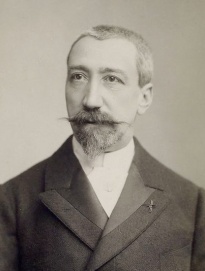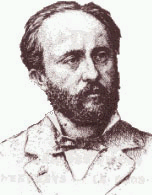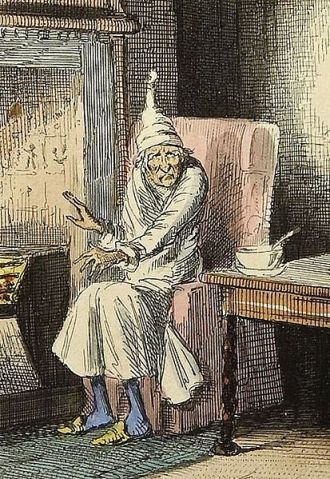My Review
A Very French Christmas: The Greatest French Holiday Stories of All Time is a joy to hold and page through, as it is beautifully produced–not surprising since it comes from New Vessel Press. This collection of fourteen stories derives primarily from the late nineteenth century, the heyday of Christmas stories, one might say, given the popularity of annual Christmas tales from Charles Dickens, Wilkie Collins, and others. But A Very French Christmas feels very French, and also very fresh, owing to the inclusion of a long story by twentieth-century writer Irène Némirovsky and new stories by contemporary writers Jean-Philippe Blondel and Dominique Fabre, commissioned expressly for this book. Although these stories can be sentimental and heartwarming at times, many of them have a bracing quality, taking an ironic view of holiday celebrations, and exploring the way people’s desires and expectations for the season can be confounded. This is equally true of the older stories.
The collection opens with a new story, “The Gift,” by Jean-Philippe Blondel, who is known for his recent, well-received novel, The 6:41 to Paris. Like that novel, this story presents another unexpected meeting between a man and woman, this time at a Christmas luncheon. Thomas, age 79 and divorced, is inwardly lamenting his feeling of abstraction from his family, gathered for their annual holiday meal at his son’s restaurant. They don’t really know him, he believes, but have erected a new identity for him as “grandpa.” Perhaps he doesn’t truly know them either, fitting each of them into his own pigeonholes. While he is musing in this rather self-absorbed way, he is brought back to life by spotting a woman he knows seated at another table.
It’s at this moment she turns her head slightly toward me and our eyes meet.
I hear a faint explosion far away. It’s like a summer storm in the middle of winter, or the start of fireworks whose noise is muffled by the distance. I can’t take myself away from her gaze. My memory has turned into a crazy machine, searching all my internal libraries for the relevant novel, and in this heap of cards and photographs that we store inside ourselves, the information that I need is right there. Because I know her.
I’m sure I know her.
His reaction is nearly physical panic–blushing, heart palpitations, that feeling that one might die from the intensity of the moment–the reactions of a much younger man, and he is thrown back in memory to four decades ago when he made her intimate acquaintance. She was a co-worker in his company, but one night she became more than that to him. And here they are meeting again. Was it chance? The answer is surprising in this well-crafted story.
After this fine start, we move back a century and a half to “St. Anthony and His Pig” (1880) by Paul Arène. But in reality, the story takes us back to the early centuries of the Christian era when St. Anthony lived alone in the Egyptian desert, fighting the battle for sanctity, with his only company being the devils who tormented him and his faithful pig Barrabas. Flaubert had recently written his novel, The Temptation of Saint Anthony (1874), so it was an opportune time for a Christmas story about the great saint’s trials. In Arène’s story, Anthony has just had six months respite from his regular temptations and prickings by a host of insidious devils. It was near Christmas, when who should visit him but a peddler of spits to roast pigs! The sly man suggests to Anthony how succulent Barrabas would be for Christmas dinner. O the torment! The mind’s imaginings are the greatest temptations, as the life of Saint Anthony abundantly proves. It is well worth following Arène’s delectable tale to the end to see what happens.
 There are three stories by François Coppée, all of the heartwarming variety and very pleasing. My favorite was “The Lost Child,” which begins with a portrait of its main character, a “millionaire banker” named M. Godefroy:
There are three stories by François Coppée, all of the heartwarming variety and very pleasing. My favorite was “The Lost Child,” which begins with a portrait of its main character, a “millionaire banker” named M. Godefroy:
On that morning, which was the morning before Christmas, two important events happened simultaneously–the sun rose, and so did M. Jean-Baptiste Godefroy.
… And whatever opinion the sun may have about himself, he certainly has not a higher opinion than M. Jean-Baptiste Godefroy has of himself.
As director of a large bank and administrator of assorted companies, he also enjoyed the possession of many honors, including the Légion d’Honneur. This prosperous, important fellow had one son, Raoul, and no wife, because Raoul’s mother had died in childbirth. Each day, M. Godefroy devoted 15 minutes of his precious business day to a visit with his son, who spent the rest of the day with servants. Nevertheless, he loved his son and looked forward to this time with him. On this Christmas Eve morning, the son used his audience with the great man to ask, “will Father Christmas put anything in my shoe tonight?” His father answered, “Yes, if you are a good child.”
After his business concluded for the day, he remembered his son’s words, and went to a toy dealer, where he bought a passel of costly presents, including a rocking horse and a box of leaden toy soldiers. But when he arrived home, the house was in an uproar and the boy’s governess was in tears because Raoul had gone missing. The story unfolds from there in a manner worthy of Dickens, and while M. Godefroy is not as miserly as Scrooge, events of this night will effect a Scrooge-like awakening.
 Two stories by the short story master, Guy de Maupassant, are both definitely of the confounding type, describing rather bizarre Christmas happenings. In “Christmas Eve,” a man explains to his friends his horror of Christmas Eve suppers. He recalled a night two years earlier when he went searching on the streets of Paris for a lady companion to share his supper. He preferred women with plenty of curves “a female colossus,” if possible, and he settled on a very curvaceous young woman who caught his eye. (Inevitably, this reminded me of de Maupassant’s famous story “Boule de Suif,” likewise concerning the misfortunes of a young lady of ample figure, and published just two years before this one.) By the end of the evening, the bewildered man would get a great surprise, and his reaction didn’t say much for his character! The other selection by de Maupassant, “A Miracle,” is a Christmas horror story about a strange blizzard and a woman’s possession by an evil spirit.
Two stories by the short story master, Guy de Maupassant, are both definitely of the confounding type, describing rather bizarre Christmas happenings. In “Christmas Eve,” a man explains to his friends his horror of Christmas Eve suppers. He recalled a night two years earlier when he went searching on the streets of Paris for a lady companion to share his supper. He preferred women with plenty of curves “a female colossus,” if possible, and he settled on a very curvaceous young woman who caught his eye. (Inevitably, this reminded me of de Maupassant’s famous story “Boule de Suif,” likewise concerning the misfortunes of a young lady of ample figure, and published just two years before this one.) By the end of the evening, the bewildered man would get a great surprise, and his reaction didn’t say much for his character! The other selection by de Maupassant, “A Miracle,” is a Christmas horror story about a strange blizzard and a woman’s possession by an evil spirit.
 In “The Juggler of Notre Dame,” by 1921’s recipient of the Nobel Prize in Literature, Anatole France, an itinerant juggler named Barnabé was blessed with enough talent at his art to earn a shower of coins from the locals wherever he performed, but this was still insufficient to live on, and he often went to sleep hungry.
In “The Juggler of Notre Dame,” by 1921’s recipient of the Nobel Prize in Literature, Anatole France, an itinerant juggler named Barnabé was blessed with enough talent at his art to earn a shower of coins from the locals wherever he performed, but this was still insufficient to live on, and he often went to sleep hungry.
One night he met a monk on the road and they fell to talking and comparing their respective work. Barnabé was grateful for what he had, and declared, “I am a juggler by trade. It would be the best trade in the world if only one had something to eat every day.” The monk gently but firmly disagreed, warning his new friend to take care, asserting instead that being a monk was the most beautiful thing in the world, “for he celebrates the praises of God, the Virgin, and the saints, and religious life is a perpetual song to the Lord.”
Barnabé was a humble man and quickly confessed his mistake. Furthermore, he said that although he liked being a juggler, he would like nothing better than to the sing the daily office, especially to the Blessed Virgin, to whom he was specially devoted. The monk held the office of Prior at his monastery and he took the former juggler under his wing. In this way, Barnabé became a monk. His only regret was his lack of education and skills such as the other monks had, because he wanted to offer worthy service to the Holy Virgin.
The biography of Anatole France at the end of this collection compares this tale to “The Little Drummer Boy.” It reminded me of “A Simple Heart” in Gustave Flaubert’s Trois Contes. Both Flaubert’s story and this tale portray the emergence of unlikely saints.
The collection ends with a long story by Irène Némirovsky, who died in Auschwitz in 1942 at the age of 39. Her major fiction Suite Française was not published until 2004. “Noël,” the story included here, is written as a screenplay, giving directions for an opening montage of photographs, “the most conventional and unsophisticated images that accompany the idea of the Christmas holidays“–heavy snow, holly and mistletoe, a yule log, bright lights, voices of children, dinner parties. Snatches of song lyrics suggest the atmosphere: “Childhood…Innocence…Dawn of the world…Dawn of love…The most wonderful days...”
Although the older generation of parents is introduced, it soon becomes clear that the story will be about two sisters, Claudine and Marie-Laure, and the men pursuing them, or discarding them, at a Christmas party. A Christmas of love affairs and heartbreak and, as improbable as it might seem in this gathering of bright young things, perhaps real love? The modernity of Némirovsky’s approach sets this story apart from the tales of the previous century.
I have described so many stories, because they were all so fascinating, just as the book’s subtitle promises. The Christmas themes are treated with a refreshing originality and variety, and I can imagine returning to reread this collection for many Christmases to come.
Stories discussed in this review:
“The Gift” (2017) by Jean-Philippe Blondel.
“St. Anthony and His Pig” (1880) by Paul Arène (trans. by J. M. Lancaster).
“The Lost Child” (1892) by François Coppée (trans. by J. Matthewman).
“Christmas Eve” (1882) by Guy de Maupassant (trans. by Frederick Caesar de Sumichrast).
“A Miracle” (1882) by Guy de Maupassant (translator unknown).
“The Juggler of Notre Dame” (1892) by Anatole France (trans. by Anna C. Brackett).
“Noël” (1932) by Irène Némirovsky (trans. by Sandra Smith, 2017).
******
A Very French Christmas:
The Greatest French Holiday Stories
of All Time
on Tour
August 8-14
***
A Very French Christmas:
The Greatest French Holiday Stories
of All Time
(short story collection)
Release date: October 10, 2017
at New Vessel Press
ISBN: 978-1939931504
142 pages
SYNOPSIS
A continuation of the very popular Very Christmas Series from New Vessel Press, this collection brings together the best French Christmas stories of all time in an elegant and vibrant collection featuring classics by Guy de Maupassant and Alphonse Daudet, plus stories by the esteemed twentieth century author Irène Némirovsky and contemporary writers Dominique Fabre and Jean-Philippe Blondel.
With a holiday spirit conveyed through sparkling Paris streets, opulent feasts, wandering orphans, kindly monks, homesick soldiers, oysters, crayfish, ham, bonbons, flickering desire, and more than a little wine, this collection encapsulates the holiday spirit and proves that the French have mastered Christmas. This is Christmas à la française—delicious, intense and unexpected, proving that nobody does Christmas like the French.
THE AUTHORS
Alphonse Daudet, Guy de Maupassant, Anatole France
Irène Némirovsky, Jean-Philippe Blondel, Dominique Fabre,
Paul Arene, Francois Coppee, Antoine Gustave Droz, Anatole La Braz
Buy the book: on Amazon
***
You can enter the global giveaway here
or on any other book blogs participating in this tour.
Be sure to follow each participant on Twitter/Facebook,
they are listed in the entry form below.
Enter here
Visit each blogger on the tour:
tweeting about the giveaway everyday
of the Tour will give you 5 extra entries each time!
[just follow the directions on the entry-form]
Global giveaway open to US residents
5 winners
***
CLICK ON THE BANNER TO READ REVIEWS
*Note:* I received this book free of charge from the publisher.






































Recent Comments